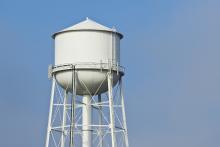Drinking Water: Information for Health Professionals
This page contains tools and resources on drinking water topics for environmental and public health professionals.
The Private Well Toolkit includes fact sheets on common private well contaminants, printable posters, a treatment device guide, quick connect cards, updated webpages, and links to related partner resources.
Contaminant fact sheets and webpages
The contaminant fact sheets describes when private well users should test, how to interpret results, and actions to take. Each fact sheet also includes a resource guide with links to additional information. All fact sheets are available in English, Spanish, and Hmong.
For each contaminant, there is also an accompanying webpage. Each page includes information from the fact sheet, along with additional information about the contaminant, such as expanded background on the substances, other exposure routes, and actions to reduce exposure from these routes.
- Arsenic in Private Well Water fact sheet, P-45012 | Arsenic webpage
- Atrazine in Private Well Water fact sheet, P-35000 | Atrazine webpage
- Bacteria in Private Well Water fact sheet, P-02132 | Bacteria webpage
- Fluoride in Private Well Water fact sheet, P-03521 | Fluoride webpage
- Lead in Drinking Water fact sheet, P-02602 | Lead webpage
- Take action if your private well has high manganese fact sheet, P-45103A | Manganese webpage
- Nitrate in Private Well Water fact sheet, P-02128 | Nitrate webpage
- Protect Yourself and Your Family From PFAS in Drinking Water fact sheet, P-03212 | PFAS webpage
- Strontium - Cycle 10 fact sheet, P-02434p | Strontium webpage
Printable posters
These posters can be printed on a standard printer. They are available in English and Spanish.
- High levels of nitrate in drinking water can affect everyone, P-02559: This poster illustrates how nitrate can affect everyone.
- Lead in Drinking Water, P-02602A: This poster highlights actions to reduce exposure to lead from drinking water.
Guides and Quick Connect Cards
- Water Treatment Devices for Private Well Contaminants Guide, P-03494: This guide describes how treatment devices work and includes a table indicating which treatment devices are best for which common contaminant. The guide is available in English, Spanish, and Hmong.
- High Levels of Nitrate in Drinking Water Can Affect Everyone Quick Connect Cards, P-02559A: These cards are a great complement to Nitrate Health Effects Poster as they highlight the main health risk of nitrate in private well water and provides links to more information. The cards can be printed on a standard printer and are available in English and Spanish.
Partner resources
- Drinking Water Tests for Private Wells (DNR): This fact sheet describes the tests that private well users should complete routinely along with tests they may want to consider testing for depending on factors in their area.
- How to Read Your Private Well Water Lab Report Guide (UW Extension: This guide describes the different sections of a lab report are, defines the terms used, provides a step-by-step guide to determine if results indicate an public health issue, and provides details how to learn more.
The Wisconsin Well Testing Access Program (WellTAP) Toolkit includes informational resources and customizable outreach tools to help local and tribal health departments (LTHDs) understand, access, and share the program.
Program overview
WellTAP is an expansion and rebranding of DHS' fee-exempt private well testing program. The goal of WellTAP is to provide private well testing for at risk groups that are unable to do so themselves.
WellTAP provides no cost testing to private well users where their primary well serves a key target group and a financial, mental, or other burden prevents them from testing on their own. The key target groups include people who are pregnant, children 12 and under, and people who are immunocompromised.
Examples of people who are immunocompromised include those undergoing active cancer treatments, people taking immunosuppressive therapy due to an organ or bone marrow transplant, or those that are being treated with biologic therapies that affect the immune system. People who have cancer, an autoimmune disease (such as Type 1 diabetes, rheumatoid arthritis, or lupus), have advanced or untreated HIV, or are over the age of 65 can also be immunocompromised.
Informational resources
- Public and Tribal Health Guide to the Wisconsin Well Testing Access Program (WellTAP), P-03666 (PDF): Overview document for LTHD staff describing what the program is, who qualifies, and how the sampling works.
- Acute Detections Response Guide (Word): Supporting document that provides LTHD staff template language to use when sharing the results of acute health hazards (bacteria, nitrate, or manganese) with well users.
- Drinking Water Health Advisory Letter Templates with Spanish Versions (Word): These supporting documents that provides language to use that provides the well user information on any substances detected above health thresholds and actions they can take to reduce exposure. These templates are now available in Spanish.
Customizable outreach tools
- Template Outreach and Advertising Materials (Word): This resource contains a message map laying out the main elements of the program as well as template newspaper and radio language, webpage content, and social media posts.
- Template Fact Sheets–These templates highlight what the program is, who is eligible, and contains room for the LTHD’s contact information and branding.
- The portrait fact sheet is now available in multiple languages:
- The landscape fact sheet is now available in multiple languages:
Faster return shipping
With the rollout of WellTAP program, the Wisconsin State Laboratory of Hygiene (WSLH) has been taking steps to improve the delivery times of fee-exempt samples.
- WSLH is setting up a program with UPS and FedEx to provide WellTAP participants with pre-paid shipping labels.
- This program will allow for next-day delivery of samples for all UPS shipments and most FedEx shipments.
- WLSH will be reaching out to LTHDs with more information shortly.
- For questions in the interim, contact Marty Collins (WSLH) at Martin.Collins@slh.wisc.edu.
Resources for public water users include contaminant-specific fact sheets, a lead in drinking water poster for display, and action guides with steps on how users can protect themselves from specific contaminants.
Contaminant fact sheets
- Take action if your drinking water has high manganese, P-45103b: This fact sheet describes what manganese is, when a water system would issue a do not drink notice, and what actions the public should take if a notice is issued. It is available in English, Spanish, and Hmong.
- Lead in Drinking Water, P-02602: This fact sheet describes actions that people should take to reduce their exposure to lead in drinking water. It is available in English, Spanish, and Hmong.
Printable poster
Lead in Drinking Water, P-02602A: This poster highlights actions to reduce exposure to lead from drinking water.
Action guides
- How to Keep Safe if You Receive a Boil Water Notice Fact Sheet, P-44589 (PDF) - This fact sheet describes actions that people should take if a water system issues a boil water notice.
- Reducing PFAS in Your Drinking Water (P-03012): This guide describes the technologies that are available for removing PFAS from drinking water, factors to consider before installing a treatment device, treatment device comparison table, and treatment device recommendations.
Partner resources
- DNR's well compensation grant program page has information about grants to address contamination in private for eligible landowners, renters and business owners.
- DNR's Drinking Water System Portal has contact information and test results for the public water systems in Wisconsin.
- DNR's annual drinking water quality reports has links to the most reports summarizing the status of water quality from public systems in the state.
Questions? Can't find what you're looking for? Contact us at dhsenvhealth@dhs.wisconsin.gov.



